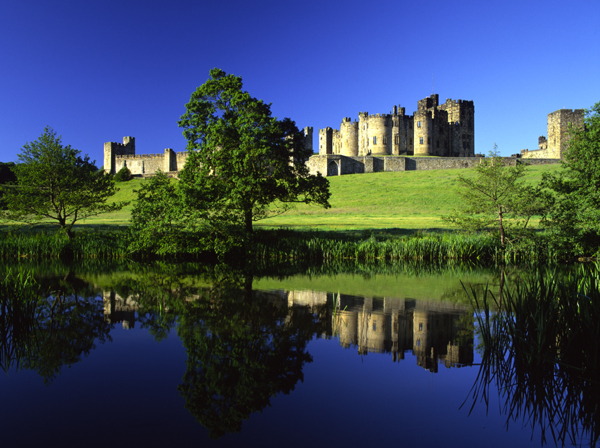The Castle was first restored, primarily as a fortress, by the 1st Lord Percy of Alnwick in the early 1300's and portions of this restoration remain today, including the Abbot's Tower, the Middle Gateway and the Constable's Tower.
|
Eustace FitzJohn of Alnwick, Malton, Halton & Chester
Eustace FitzJohn acquired the castle and estates of Alnwick and Malton as a result of his marriage to Beatrice, only daughter of Ives de Vesci and his wife, Alda, only daughter and heiress of William Tyson, Lord of Alnwick and Malton. A son, William FitzEustace, was born to this marriage. With his marriage to Beatrice de Vesci, Eustace FitzJohn began to develop an even firmer stronghold to add to his influence and powers in the north of England. Upon the death of Beatrice de Vesci, Eustace married Agnes, also called Maude, daughter of William FitzNigel (Fitz Neel), of an old and distinguished Norman family who were descendents of a Norse companion to Rollo the Viking. Rollo in 911, became first Duke of Normandy and was an ancestor of William the Conqueror. William Fitz Nigel was Baron of Halton, Hereditary Constable and Marshal of Chester and also Viscount of Coutances, Normandy. This marriage extended Eustace's influence across England from the east coast to the mouth of the River Mersey on the west coast which was commanded by the castle at Halton. Eustace held Halton and was constable of Chester Castle. Eustace Fitz John supported Empress Matilda against King Stephen and Matilda, Countess of Boulogne. He surrendered Alnwick to the invading Scots King but they were beaten at the battle of the Standard in 1138. Eustace became reconciled to Stephen and Matilda who allowed him to retain Bamburg and Alnwick. At the latter he founded Alnwick Abbey of which now only a few ruins remain. His second wife, Agnes was daughter of William Fitz Nigel, who had prospered under Henry I and held many manors throughout England and was hereditary constable of Chester Castle. FitzNigel's son died and his daughter became heiress. Through his marriage to Agnes Fitz Nigel, Eustace Fitz John became Lord of Halton and constable of Chester continuing the work of fortifying both places. The castle at Chester has been upgraded and maintained throughout the centuries, but Halton castle was allowed to fall into ruin and in the 18th century a hotel was built within the castle and doubtless the stones being reused.The village of Halton has now been absorbed by industrial Runcom and as such is dormitory suburb, the development of which has resulted in a maze of villas. The completion of nearby Norton Priory was one of the works that Eustace assumed from his father in-law. The priory was financed by the grant of church rights in many manors throughout England and an interesting coincidence is that Pyrton in Oxfordshire was among them. The appointment of a canon of Norton as priest at Pyrton continued up to the Reformation when the priory was sold to Sir Richard Brook in 1545. Among offices and lands bestowed upon Eustace FitzJohn by Henry I were the lands of Knaresborough and Aldborough. During the civil war a few years later, King Stephen attempted to seize some of Eustace's permanent holdings and to cancel all temporary custodianships for siding with Empress Matilda during the civil wars. Eustace managed to regain or retain his permanent possessions, including Alnwick, Malton, Halton, and the Chester constableship, but permanently lost Aldborough and Knaresborough.Eustace's aid to Matilda during the wars, contributed to several of Stephen's greatest setbacks. Although partially reconciled with Stephen after the war, Eustace continued to be loyal to Matilda and exerted almost complete independence in his northern barony, even coining his own money. The children born to Eustace FitzJohn and Agnes FitzNigel included Geoffrey, John, and Richard. In addition to a string of castles across the north of England, Eustace Fitz John left three lines of descendants who each took a part in the life of the country. Two lines died out in later centuries but the line founded by his grandson John FitzEustace in Ireland has continued with varying fortunes to this day. |
